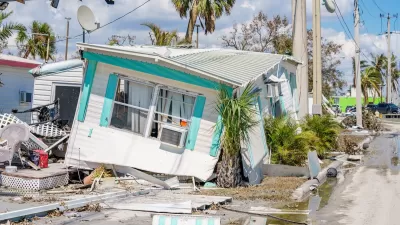NJ's Republican Gov. Chris Christie heaps praise on President Obama, and the governor of the neighboring, hard-hit state, NY Gov. Andrew Cuomo, has also stirred the political pot by going where no other pol has gone - linking Sandy to climate change.
As has been noted here (Why the Silence on Climate Change?), glaringly absent from the presidential debates has been climate change, and except for a brief reference by both in their convention speeches (one acknowledging it and the other mocking it), it goes unmentioned among most major political leaders, until now.
Peter Fimrite writes that "Cuomo was the first politician to publicly link the superstorm to climate change, urging governments and the public to take note of the consequences likely to occur if the world continues to ignore the phenomenon."
"Part of learning from this is the recognition that climate change is a reality. Extreme weather is a reality. It is a reality that we are vulnerable," Cuomo said Wednesday during a news briefing after a helicopter tour of storm-ravaged areas."
Cuomo calls the linkage between extreme weather and climate change "a conversation I think is overdue".
Cuomo's boldness was matched by NYC Mayor Michael Bloomberg who cited climate change as a chief reason for his endorsement of President Obama, writes Daniel Strauss in The Hills Blog Briefing Room.
"Our climate is changing. And while the increase in extreme weather we have experienced in New York City and around the world may or may not be the result of it, the risk that it might be - given this week's devastation - should compel all elected leaders to take immediate action," Bloomberg wrote in his endorsement.
Cuomo may be the first sitting pol to do so, but others - in the science community and even the insurance industry have already done so.
The well-organized climate change skeptics wasted no time in discrediting Gov. Cuomo.
"Leave it to global warming alarmists to exploit the innocent victims of a human tragedy like Hurricane Sandy to spread the laughably false notion that global warming caused the storm," wrote James Taylor, a senior fellow for environment policy at The Heartland Institute, in Forbes.com. "Shame on those alarmists for asserting a false connection to global warming to 'make lemonade' out of this tragedy."
The precise nature of the connection of climate change to Hurricane Sandy is far from settled in the eyes of much of the scientific world, but a growing consensus appears that there is a relationship.
In Paul M. Barrett's Oct. 28 article, "It's Global Warming, Stupid in Bloomberg Business Week, "Eric Pooley, senior vice president of the Environmental Defense Fund...offers a baseball analogy: "We can't say that steroids caused any one home run by Barry Bonds, but steroids sure helped him hit more and hit them farther. Now we have weather on steroids."
Fimrite quotes Peter Roopnarine, the curator of geology and a climate researcher at the CA Academy of Sciences in San Francisco.
"Kudos to Gov. Cuomo," he said. "The science is sound, and we in the scientific community are in agreement. It is time for politicians to begin talking about this every day and not be afraid of organizations like the Heartland Institute."
FULL STORY: N.Y.'s Cuomo links storm, climate change

Study: Maui’s Plan to Convert Vacation Rentals to Long-Term Housing Could Cause Nearly $1 Billion Economic Loss
The plan would reduce visitor accommodation by 25,% resulting in 1,900 jobs lost.

North Texas Transit Leaders Tout Benefits of TOD for Growing Region
At a summit focused on transit-oriented development, policymakers discussed how North Texas’ expanded light rail system can serve as a tool for economic growth.

Why Should We Subsidize Public Transportation?
Many public transit agencies face financial stress due to rising costs, declining fare revenue, and declining subsidies. Transit advocates must provide a strong business case for increasing public transit funding.

How to Make US Trains Faster
Changes to boarding platforms and a switch to electric trains could improve U.S. passenger rail service without the added cost of high-speed rail.

Columbia’s Revitalized ‘Loop’ Is a Hub for Local Entrepreneurs
A focus on small businesses is helping a commercial corridor in Columbia, Missouri thrive.

Invasive Insect Threatens Minnesota’s Ash Forests
The Emerald Ash Borer is a rapidly spreading invasive pest threatening Minnesota’s ash trees, and homeowners are encouraged to plant diverse replacement species, avoid moving ash firewood, and monitor for signs of infestation.
Urban Design for Planners 1: Software Tools
This six-course series explores essential urban design concepts using open source software and equips planners with the tools they need to participate fully in the urban design process.
Planning for Universal Design
Learn the tools for implementing Universal Design in planning regulations.
City of Santa Clarita
Ascent Environmental
Institute for Housing and Urban Development Studies (IHS)
City of Grandview
Harvard GSD Executive Education
Toledo-Lucas County Plan Commissions
Salt Lake City
NYU Wagner Graduate School of Public Service





























